Connected Behaviors
By Lee Alan Dugatkin
Animals use complex social networks to disseminate practices that are distinct to their geographic and cultural groups.
Animals use complex social networks to disseminate practices that are distinct to their geographic and cultural groups.

A core tenet of evolutionary biology is that for the process of natural selection to act on a behavioral trait, three things must be in place. First, there must be different behavioral variants in a population. For example, if the behavior is mate choice, then some animals might prefer colorful, risk-taking mates and others might prefer drabber-colored, risk-averse mates.
Without behavioral variation, there is nothing for natural selection to select on. But variation itself is not enough for natural selection to act: That variation has to map onto reproductive success, even indirectly. If behavioral variation does not translate into fitness differences, it does not lead to evolutionary change. And, finally, behaviors have to be transmitted, with a reasonably high degree of fidelity, from generation to generation. Without a system of inheritance, any fitness differences associated with behavior in one generation are washed away in the next.
When Austrian monk Gregor Mendel’s experiments on peas (among other things) were rediscovered in the early 1900s, it became clear that genes are one means of transmitting traits, including behavioral traits, across generations. Indeed, for the next 50 years or so, evolutionary biologists and animal behaviorists assumed genes were not only one way to transmit traits across generations—they were the only way. But in time, ethologists began to learn of another transmission system. In their studies of the foraging behavior of Japanese macaques in the 1950s and 1960s, primatologists Shunzo Kawamura of Osaka City University and Masao Kawai of the Japan Monkey Center in Aichi found that behavior could be passed down across generations in nonhumans not only genetically but also via cultural transmission. What’s more, cultural transmission occurs not just between generations, from parent to offspring, but also within generations, from peer to peer.
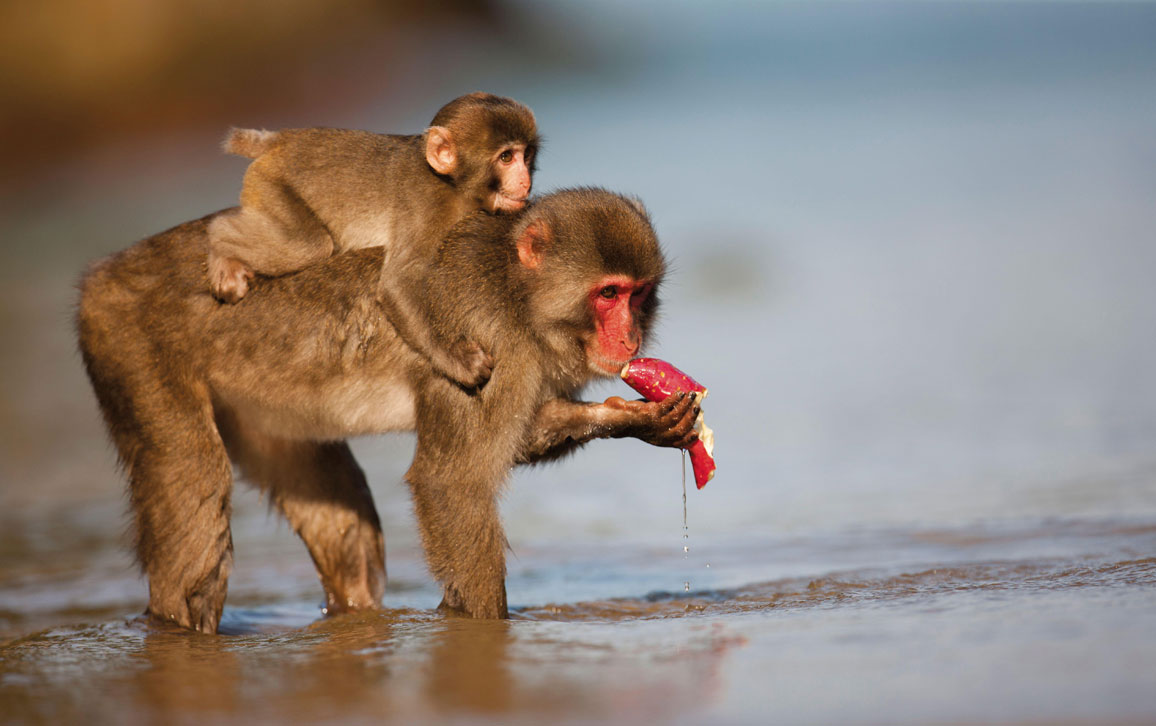
Nature Picture Library/Alamy Stock Photo
Starting in the 1950s, Kawamura and Kawai studied a troop of Japanese macaques (Macaca fuscata) who lived on Kōjima Islet (then called Koshima Islet) in Japan. The researchers threw sweet potatoes and wheat on the sandy beach so the monkeys would get used to the presence of humans. When one macaque, whom they named Imo, was about a year old, she began to do something no macaque on the island had ever been seen doing: She washed her sweet potatoes in water before she ate them, dislodging all the sand and making the sweet potatoes all the tastier. If Imo were the only one who did this, her innovation would have died with her. Instead, many of Imo’s peers and relatives learned the skill of potato washing from Imo via cultural transmission: by watching her clean her potatoes and trying it themselves.
Imo’s standing as a cultural icon among the macaques on Kōjima only grew stronger. When she was four, she found a better way to handle the wheat the humans threw on the beach. Wheat and sand mixed together are edible, but not especially appetizing. Imo came up with a novel solution to that problem too: She tossed her wheat and sand mixture into the water. The sand sank and the wheat floated. This innovation is a bigger deal than it sounds, because primates virtually never let go of food once they have it in their hands. But to get the sand off, Imo had to release the wheat, and that’s what she did. And as with the sweet potatoes, Imo’s troop mates learned this new trick from her. More than 70 years later, long after Imo’s death, macaques on Kōjima Islet still wash their sweet potatoes and clean their wheat, and they, and we, have Imo to thank for it.
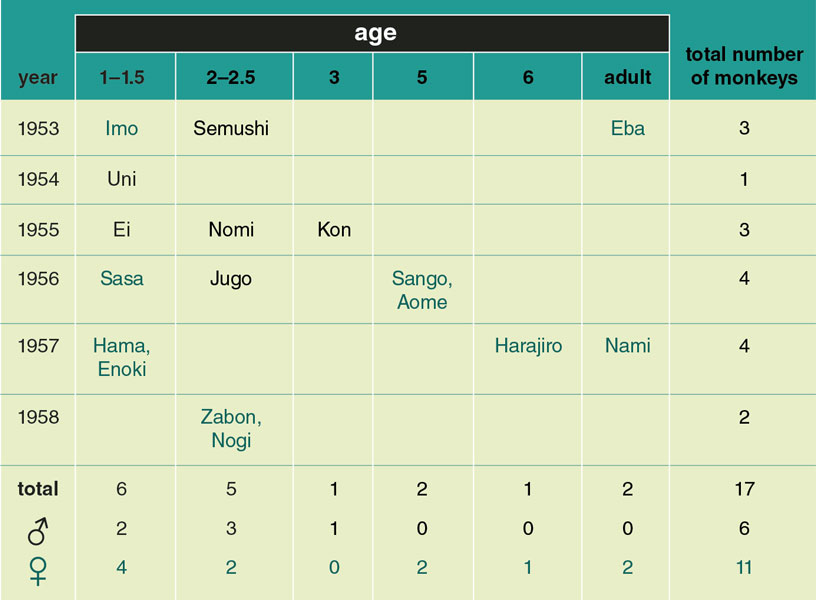
Adapted from Kawai, 1965
Kawamura and Kawai didn’t use social network theory to understand how Imo’s foraging innovation spread through her group, for the simple reason that social network theory per se didn’t yet exist. But many decades later when Janet Mann was studying culture and tool use in bottlenose dolphins in Australia, it did.
Tool use does not necessarily involve crafting wheels or gears—a definition that almost guarantees it will be seen only in humans—it simply means shaping an object to serve some function. New Caledonian crows (Corvus moneduloides) extract insects from under tree bark using tools constructed from twigs whose leaves have small, sharp barbs running along their edges. Insects react and grab the inserted twig, and the crows pull out the twig tool and eat whatever is clamped on. Novice crow toolmakers begin by constructing simple tools, and as they mature, they start to build more complex ones. New Caledonian crows can even build tools from multiple parts, and remarkably they safeguard their best and favorite tools to reuse.
Tools solve problems. For bottlenose dolphins (Tursiops aduncus) in Shark Bay, Australia, the problem centers on poking and probing the sand with their snouts to scare up fish such as spothead grubfish (Parapercis clathrata) from the bay bottom. It is anything but pleasant pounding your snout betwixt and between the rocks down there, so a small fraction of dolphins in Shark Bay, primarily females, pick up a basket sponge using their snout, wiggle that snout snuggly into the sponge, and use it to cushion the blow of probing the rocky bay bottom, effectively turning another organism into a tool. Shark Bay females take the choice of sponge seriously, often spending 10 minutes finding just the right size and shape to fit their snout, and then swimming to their favorite hunting ground along channels between 8 and 14 meters deep. If a dolphin “sponger” does shake loose a bottom-dwelling fish hiding in the sand, they toss the sponge off and chase their prey. When they are done with that, if the sponge was a particularly good fit, they go back and retrieve it for further use.
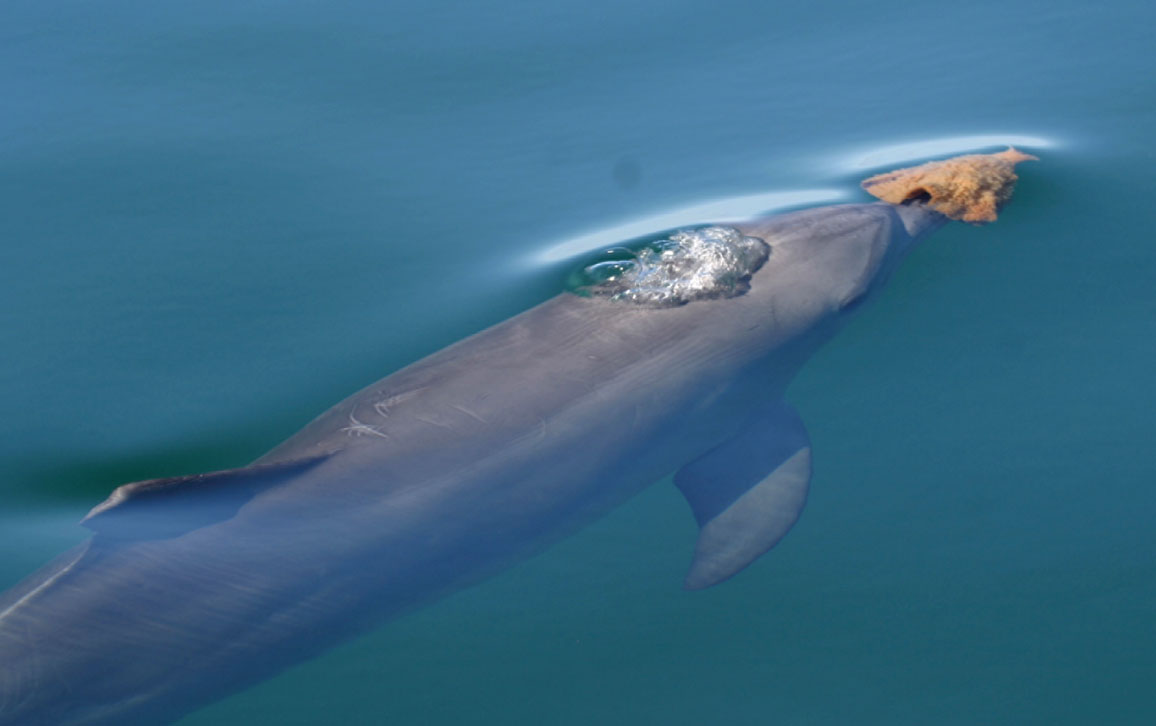
Courtesy of Ewa Krzyszczyk
Shark Bay, which is near the conservation park Monkey Mia, sits on the west coast of Australia, about 850 kilometers northeast of Perth. The bay is huge, covering 13,000 square kilometers, with an average depth of about 9 meters, and is home to not only more than 1,000 bottlenose dolphins, but also 16,000 dugongs (Dugong dugon), a marine mammal whose closest living relative is the manatee. Within its waters, it also has the world’s largest seagrass banks, and the stromatolite fossils at Hamelin Pool Marine Nature Reserve in the bay date back almost three billion years. And, of course, Shark Bay is home to many sharks, some of whom feed on dolphins.
Since the Shark Bay Dolphin Project began in 1984, team members have gathered data on more than 1,500 bottlenose dolphins. Researchers have amassed a giant dolphin mug shot book identifying individual dolphins based not only on sex, but by using fin shape, as well as the shape of scars, often from shark bites, on the fin and body.
Even before sponging behavior was discovered at Shark Bay, Janet Mann was there studying the dolphins. Mann is now a professor of biology and psychology at Georgetown University, but in 1988 she was a PhD student at the University of Michigan, working with animal behaviorist and primatologist Barbara Smuts. Smuts had become interested in the mother–calf interactions in the Shark Bay dolphins. One of Smuts’s assistants on the dolphin project canceled at the last minute, and because Mann had done some undergraduate work on mother–infant interactions in baboons at Amboseli Park in Kenya, Smuts asked her to step in and help with the dolphin work, which Mann was more than happy to do.
Mann was part of the Shark Bay research team that first documented sponging behavior in 1995, and for almost 30 years, she and her colleagues have diligently been piecing together how this behavior has spread along social networks to a subset of dolphins in the bay. As in the literature on human culture, in animal behavior literature, one of the defining features of culture is that it differentiates groups from one another: “I was very much interested . . . in whether the dolphins had a concept of ‘this is the way we do things and it’s different from the ways others do it,’” Mann says. “Does that bind them together? Social network analysis lets you get at this with a mathematical method.” Fortunately, Lisa Singh, a computational computer scientist at Mann’s home institution, Georgetown, was already working with Mann to develop a custom database for the dolphins at Shark Bay. Singh also had experience working with social networks, and soon she, Mann, and their collaborators were looking at data on culture and sponging behavior from a network perspective.
When Mann and her colleagues began their social network analysis, they knew quite a bit about sponging behavior and spongers in Shark Bay. They were certain sponging worked as a foraging technique, not only because they could, if conditions were just right, see the dolphins sponging as they watched from their boat, but because they did some sponging themselves. They’d dive in an area that sponging dolphins liked and record the dolphins. Then, they’d do a second dive at the same spot, and while some divers recorded, others probed the bottom wearing sponges on their hands. When they compared the videos, they were amazed by just how many bottom-dwelling fish were stirred up when human spongers shook up the otherwise safe world of those fish.
Mann knew spongers tended to be female. Although the occasional male puts a sponge on and probes the bay bottom, for the most part males are more interested in forming coalitions and alliances that help them secure mating opportunities than they are in specialized tool use. Mann was also aware that except for a dependent calf who might be swimming beside her mother, when female spongers foraged, they did so alone; but dolphins who were not spongers tended to search for food in groups. She also knew that spongers always had a mother who was a sponger, and she hypothesized that young dolphins were copying—a type of cultural transmission—their mother’s sponging behavior.
Cultural transmission from parent to offspring can be hard to nail down because it looks a lot like genetic transmission of behavior from parent to offspring. In both, something is passed down from a parent. In cultural transmission, that something is a skill, like how to forage using a sponge; in the genetic transmission, it is genes associated with the behavior that are transmitted across generations. Behavioral ecologist Michael Krützen led a team of researchers, including Mann, who employed molecular genetic tools to rule out genetic transmission. They found that sponging is indeed a culturally transmitted trait from mother to offspring.
Nonspongers may have had more connections in the network, but spongers were forming cliques within that network, preferentially interacting with each other rather than with nonspongers.
What Mann didn’t know was whether female spongers were somehow networking with one another. Recall that sponging is a solitary affair, except for a female who sometimes has a dependent calf with her, which means that spongers are not networking while they sponge. But sponging behavior takes up only a small part of a dolphin’s day. Perhaps adult female spongers network with one another when they’re not sponging? “Spongers [sometimes] carry their sponges and will join with other spongers with sponges on,” Mann says. “They aren’t foraging then, just hanging out.” What’s more, females who use a sponge once tend to specialize in sponging, which means that if you are a sponger, even if another sponger isn’t wearing a sponge when you see her, as long as you’ve seen her with a sponge on at some point, you can be fairly certain she is still a sponger.
To construct bottlenose association networks, Mann and her team looked for who was swimming near whom when dolphins were not foraging. Dolphins were considered to be associating if they were within about 10 meters from one another or were linked to each other through another individual using the same 10-meter rule. Mann used historical association patterns of 36 spongers and 105 nonspongers gleaned from almost 15,000 surveys that detailed where dolphins were between 1989 and 2010, what they were doing, and which dolphins they were swimming with.
What the social network analysis of these 141 dolphins revealed was that nonspongers were better connected than their sponger counterparts. Nonspongers had more associates and stronger bonds with those associates than did spongers. Nonspongers also had more friends and friends of friends. Part of the deeper connectedness of nonspongers in the network is due to their tendency to forage in groups: Although foraging behavior was not part of the network analysis per se, nonspongers probably spend more time around others in anticipation of group foraging events.
The one major social network metric for which spongers had higher values than nonspongers was the clustering coefficient, which, among other things, measures cliquishness. Nonspongers may have been more connected in the overall network, but spongers were forming cliques within that network, preferentially interacting with each other rather than nonspongers. But why? What were spongers getting from membership in a clique? If sponging is a solitary affair, why bother hanging around other foragers? Mann and her colleagues think at least part of the answer is that although a sponger always learns the skill of sponging from its mother, and only its mother, it may be that spongers can get another bit of important sponge-related information—namely, where the good sponges are located—from swimming around with others in their social network clique.
Remarkably, dolphins are not alone in using sponges and in utilizing networking as a means for using them effectively. Chimpanzees also use sponges, but they network in a very different way than bottlenose dolphins. But rather than focusing on sponges, let’s peer in on the culture network of a cetacean relative of those bottlenose dolphins.
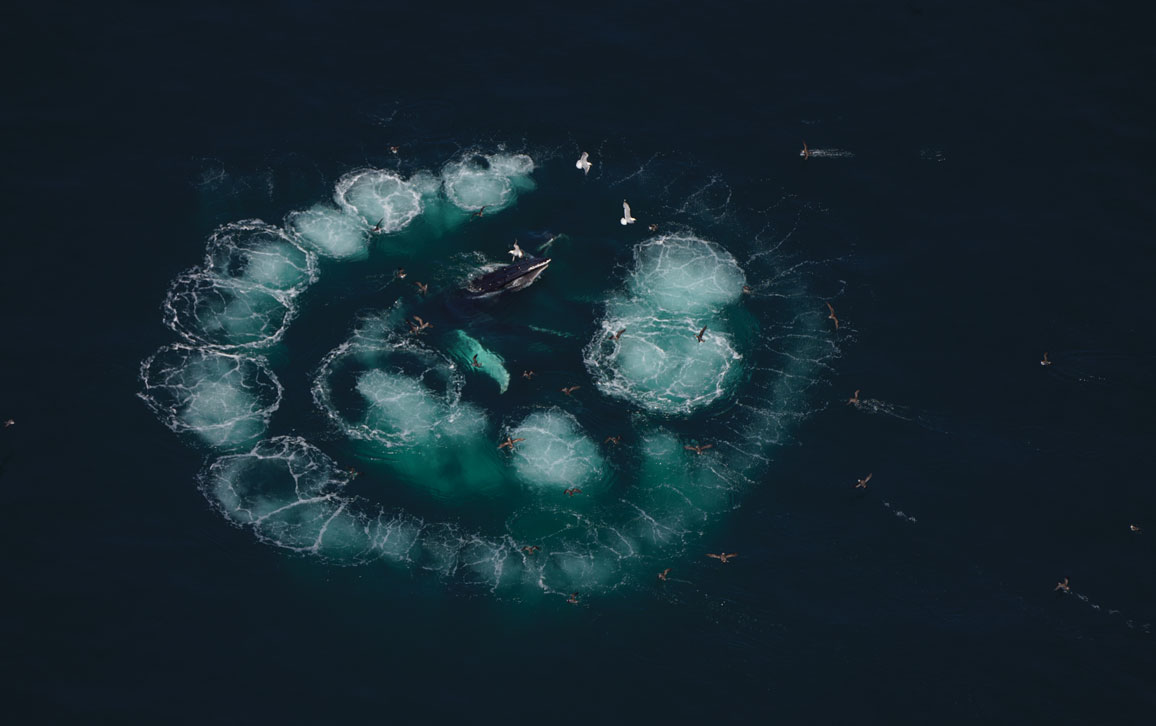
New England Aquarium
“I was one of those kids,” Jenny Allen recalls, “that said I was going to grow up to work with whales, and everybody kind of went ‘Yeah, OK, but, like, you’re going to get a real job eventually.’” Eventually she did get a real job—working, as she predicted, with whales. As an undergraduate, Allen studied marine biology and landed an internship at the Whale Center of New England in Gloucester, Massachusetts. Soon she was spending her time on boats, studying humpback whales (Megaptera novaeangliae) in the Gulf of Maine’s Stellwagen Bank National Marine Sanctuary, about 50 kilometers southeast of the Whale Center. When she graduated, Allen got a full-time position at the Whale Center and continued her work along Stellwagen Bank, watching the magnificent creatures she so loved.
Whale research can be tricky, as it often involves a deep tie with ecotourism and whale-watching expeditions. Allen had connections with whale-watching companies in the area, and she’d go out with them as an onboard naturalist. She’d narrate the adventure for the 100 or 200 people on the boat, and, in return, she and her assistant were permitted to gather basic information on the whales, including their feeding behavior. They would also take photos, focusing on a whale’s tail—the pattern on the tail is the equivalent of a whale fingerprint—and comparing it with the book full of tail shots they had with them.
By the early 2000s, nearly 40 percent of the whales were using lobtailed feeding. Naive whales who spent time with lobtailers seemed to learn this new tradition by observation.
Usually, the arrangement that Allen had with the captain of a boat worked well, but at times it could be a delicate balancing act. On a day when a ship wasn’t encountering all that many whales, Allen might be ready to move on after 15 or 20 minutes with a whale they did encounter. But she would often have to spend time trying to persuade the captain, whose job it was to maximize the time passengers on board could spend with the whales they paid good money to see, that they should indeed move on and hope they would encounter another whale. Unless it was just the right captain, in just the right mood, the ship stayed perched in front of the whale who was a sure thing.
Standing on deck, Allen was often transfixed by a strange behavior that seemed to be spreading across the population of the 1,300 whales she was studying. Whales in the Gulf of Maine (and elsewhere) had long been known to use a hunting technique called bubble feeding, in which a whale dives 20 meters below the surface and gives off five or six blasts of breath around a school of prey fish. These bursts of air create a bubble ring underneath and around the prey, and when the bubble ring reaches the surface, the whale crashes through it, grabbing a meal as it does. But all of that wasn’t enough for one humpback whale, who sometime in 1980 added a new twist to the bubble feeding sequence. Right before diving to commence a bubble feed to capture a school of fish, that whale slapped its tail on the water surface, in what has been dubbed lobtailed feeding. Soon, a few other whales were doing the same—though the number of slaps at the water surface varied from whale to whale—and by the time Allen was watching in the early 2000s, nearly 40 percent of the whales were using lobtailed feeding. It seemed to Allen that the lobtailing was spreading through whale networks via cultural transmission: Naive whales who spent time with lobtailers seemed to learn this new tradition by observation. Still, she knew that she couldn’t be anything close to sure of her hypothesis based solely on her observations.
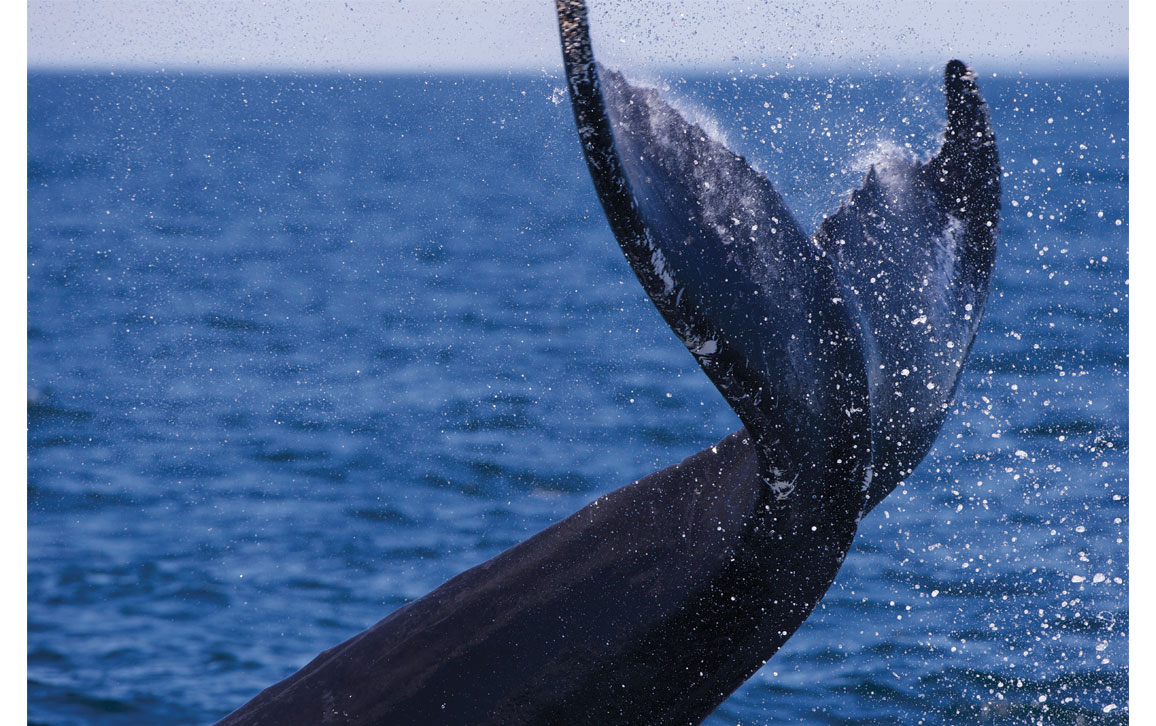
Arturo de Frias/Alamy Stock Photo
Allen’s interest in the role that social networks might play in the spread of lobtail feeding via culture began in 2010 when she entered the master’s program at the University of St. Andrews in Scotland. There, she worked with network-modeling guru William Hoppitt and with Luke Rendell, an expert on culture in animals. “Look, do you have any projects that would make a good master’s thesis?” Allen asked Rendell and Hoppitt. “[Because] if not, I have access to this dataset—maybe we [could use] that?” Allen had kept on good terms with the Whale Center, and the dataset she was referencing was brimming with information on lobtail feeding in humpbacks in the Gulf of Maine since 1980. Fortunately, Hoppitt was developing some new social network models and had not yet had the chance to apply them to a wild population or to a dataset as massive as the one Allen had access to, and he was excited to do so. Rendell, who knew a great opportunity to study cultural transmission when he saw one, was keen on the idea as well.
Allen’s thesis involved getting the nearly 30 years of data on lobtail feeding at Stellwagen Bank into a form that could be used in a social network analysis. That wasn’t easy. Over the course of three decades, that data had been collected by dozens of different people, with varying degrees of expertise on foraging behavior in humpbacks. “The [observer] didn’t necessarily say, ‘This animal was lobtail feeding,’” she notes, “[but] because I could speak the language of that data collection . . . I [could] say, ‘Oh, this sequence of behavior is lobtail feeding.’”
Allen searched through 73,790 time-tagged whale-sighting records, involving 653 individuals, each of whom had been seen at least 20 times. She coded a whale with a zero if, up to that point in time, it had never been seen lobtail foraging, or with a one if it had been seen lobtail feeding at any point in the past. In addition, for records involving multiple individuals, Allen noted which whales were found together. Even after all that coding was complete, there were still technical hurdles. The dataset was so large that the computer model Hoppitt had built couldn’t handle it all and crashed. But Hoppitt was up to the challenge and made the necessary adjustments, and soon the data and the model were syncing up.
If whales who were naive to lobtail foraging picked up this technique by watching lobtailers—that is, if lobtailing was spreading through the whale social network via cultural transmission—then, as a general rule, lobtailers should be seen associating with lobtailers. To see why, imagine a group of five whales who tend to spend time together. Suppose three of the whales are lobtailers and two aren’t. If the two naive whales learn lobtail foraging from the others, then the next time that group of five whales is observed, and every time after that, they will all be lobtailers. The social network model that Hoppitt built was designed to ask if this scenario was in fact what the nearly 74,000 records were showing.
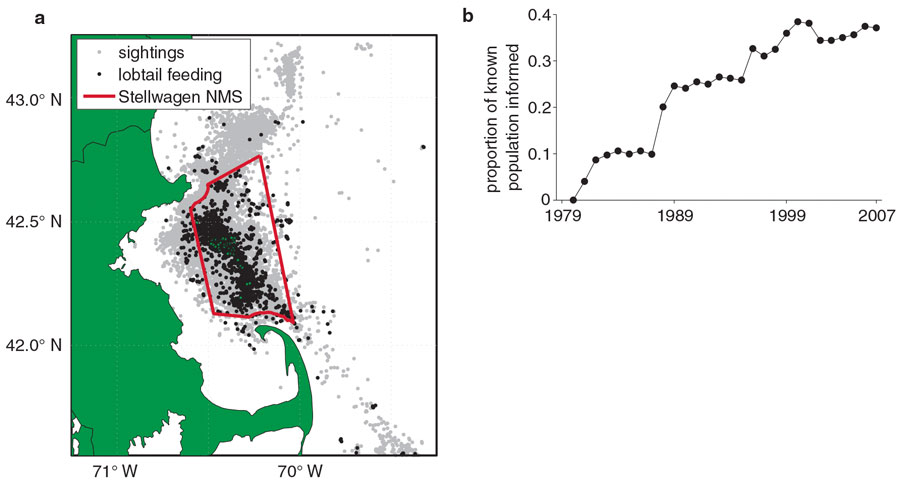
From Allen, 2013
What Hoppitt’s model did was compare the probability that a naive whale was learning how to lobtail by observing lobtailers versus the probability that it somehow learned lobtail feeding on its own, by simple trial-and-error learning. To make that comparison, the model calculates a “social transmission effect,” which captures how much interacting with knowledgeable individuals accelerates the pace at which a whale picks up the lobtailing behavior, relative to trial-and-error learning. The social transmission effect was huge and the results striking: so striking that Rendell didn’t believe what he was seeing. “Luke basically was like, ‘Oh, you’ve done something wrong,’” Allen says. “‘You have to go back [and reanalyze].’” Allen, Rendell, and Hoppitt did check after check of the code and the data, looking for some sort of error or artifact, but the results held up. Still, Allen and her colleagues wondered whether there was some other, possibly simpler alternative than cultural transmission that could explain why lobtailers in the foraging network were associating with one another.
Simply hanging around where the sand lance were did not explain why lobtail foraging had spread. Instead, the practice was spreading along the humpback whale network via cultural transmission.
Allen knew that lobtail feeding most often occurs when whales are foraging on sand lance (Ammodytes americanus), a fish found in the Gulf of Maine. Maybe the reason that lobtailers were found together was not that lobtailing behavior spread throughout their foraging network by cultural transmission, but because the lobtailers were all drawn to the sand lance populations. To test for this possibility, Allen and her colleagues discarded all associations after a whale had been seen lobtail foraging for the first time. So, for example, imagine that whale 1 was spotted lobtail feeding on sand lance for the first time on December 31, 1999. Allen and her colleagues would know who whale 1 was swimming around with before that date. If they focused on that time period, they could test if whale 1 had been interacting with lobtailers before being a lobtailer itself. That meant they didn’t need to worry that, starting January 1, 2000, lobtailing whale 1 might be associating with other lobtailers because they all just cluster around sand lance. When they analyzed the data this way, they found that simply hanging around where the sand lance were did not explain why lobtail foraging had spread as it had. As Allen had long thought was true but had no way of knowing for certain until they took social networks into account, information about lobtail feeding was spreading along the humpback whale foraging network via cultural transmission.
Whether it’s macaques on Kōjima Islet, bottlenose dolphins in Shark Bay, or humpback whales in the Gulf of Maine, cultural transmission plays a role in the dynamics of social networks. The more we learn about social networks in nonhumans, the more we realize that those networks are remarkably complex. This recognition has led to new lines of collaborative research. Historically, fields such as animal behavior, disease ecology, and conservation biology have been distinct, and often disjointed, research enterprises. Social network analysis is an ideal bridge between them.
This article is excerpted and adapted from The Well-Connected Animal: Social Networks and the Wondrous Complexity of Animal Societies, published by the University of Chicago Press, © 2024 by Lee Alan Dugatkin.
Click "American Scientist" to access home page
American Scientist Comments and Discussion
To discuss our articles or comment on them, please share them and tag American Scientist on social media platforms. Here are links to our profiles on Twitter, Facebook, and LinkedIn.
If we re-share your post, we will moderate comments/discussion following our comments policy.